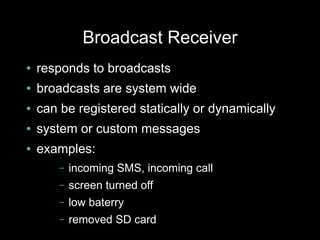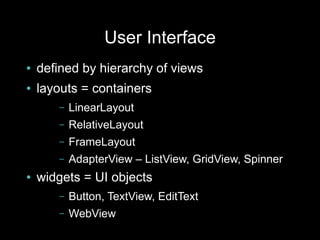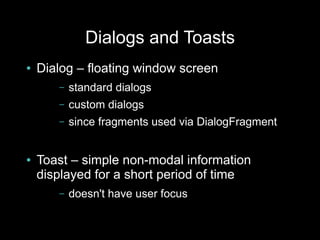Android development - the basics, MFF UK, 2012
- 1. Android Development - the basics Tomáš Kypta @TomasKypta
- 4. Outline ● Android platform ● Android ecosystem ● Android SDK and development tools ● Hello World ● building blocks & the manifest file ● activities, widgets, intents ● dialog, toasts, notifications ● fragments
- 5. Android platform ● Linux-based operating system ● open-source ● originally phone OS ● tablet (since Honeycomb, Android 3.0) ● Google TV ● hundreds of devices
- 6. History ● 2003, Android inc. ● 2005 acquired by Google ● Sep 2008 first Android phone – T-Mobile G1 ● since then rapid development of the platform ● May 2010 Froyo ● Feb 2011 Honeycomb ● Oct 2011 Ice Cream Sandwich ● Jul 2012 Jelly Bean
- 8. Android ecosystem ● the world's most popular mobile platform ● 1.3M new devices activated every day ● of that 70k tablets ● total number of devices ~ 500 million ● play.google.com (market.android.com) ● other store – Amazon Appstore for Android, ...
- 9. Google Play ● ~ 675 000 apps in the market ● total downloads > 25 billion ● ~ 70% free apps ● ads, in-app billing ● selling – 15 min return period ● buy – ČR, SR ● sell – ČR ● Google Play contains also music, books – not available in ČR, SR
- 10. Android problems ● fragmentation ● manufacturer/carrier enhancements ● updates & support ● openness – low quality apps in Google Play ● malware - users
- 11. Permissions ● users accept when installing or updating the app ● apps can be installed directly from .apk file
- 12. Sources ● developer.android.com ● android-developers.blogspot.com ● source.android.com ● stackoverflow.com ● youtube.com/androiddevelopers ● svetandroida.cz
- 13. Development ● programming in “Java” ● native apps possible (C++) ● development tools platform friendly ● Windows, Linux, Mac OS X ● IDE support – ADT plugin for Eclipse, Netbeans, IntelliJ IDEA, ... ● you can freely develop on your device
- 14. Android SDK ● android – Android SDK and AVD Manager ● adb – Android Debug Bridge ● ddms – Dalvik Debug Monitor ● emulator ● lint, hierarchyviewer, Traceview ● ProGuard ● docs, samples
- 15. Libraries ● compatibility libraries – v4 – backports lots of newer functionality to android 1.6+ ● licensing, billing libraries ● AdMob ● Google Analytics, Flurry, Crittercism, ... ● C2DM
- 17. Hello World
- 18. Build
- 20. Android Building Blocks ● Activity ● Service ● Content provider ● Broadcast receiver ● AndroidManifest.xml
- 21. Activity ● screen with user interface ● the only visual component ● example – an email app can contain: – list of emails – email detail – email composition – preference screen – ...
- 22. Service ● has no UI ● long-running tasks ● examples: – music playback service – download service – sync service
- 23. Content Provider ● manages and shares application data ● data storage doesn't matter – database, web, filesystem ● apps can query and modify data through content provider ● read/write permissions can be defined ● examples: – all system databases – contacts – SMS
- 24. Broadcast Receiver ● responds to broadcasts ● broadcasts are system wide ● can be registered statically or dynamically ● system or custom messages ● examples: – incoming SMS, incoming call – screen turned off – low baterry – removed SD card
- 25. AndroidManifest.xml ● defines what parts the app have ● defines which endpoints are exposed ● minimum/maximum API level ● permissions ● declare hardware and software features ● required configuration
- 26. Intent ● asynchronous message ● binds components together (all of them except ContentProvider) ● starting activities ● starting services and binding to services ● sending broadcasts
- 27. Activity ● a subclass of android.app.Activity ● app usually has many activities ● activities managed in activity stack – newly started activity is place on the top of the stack
- 28. Activity Lifecycle ● activity can be in different states during it's lifecycle: – foreground – visible – stopped – killed ● when activity state changes a system callback is called
- 29. Activity callbacks ● onCreate() - activity created ● onStart() - becoming visible to the user ● onResume() - gains user focus ● onPause() - system resuming previous activity ● onStop() - becoming invisible to the user ● onDestroy() - before activity destroyed ● onRestart() - if it was previously stopped, prior to onStart()
- 31. Intent & Activity ● starting activity explicitly ● starting activity implicitly ● starting activity for result
- 32. Configuration changes ● when configuration changes activities are destroyed and recreated by default – place for lots of bugs ● behaviour can be changes ● it is preferred to properly handle config changes – onSaveInstanceState(Bundle)
- 33. User Interface ● defined by hierarchy of views ● layouts = containers – LinearLayout – RelativeLayout – FrameLayout – AdapterView – ListView, GridView, Spinner ● widgets = UI objects – Button, TextView, EditText – WebView
- 34. List Widgets ● displays a list of items (some view) – ListView, Spinner, GridView, Gallery ● use adapter to bind list to data
- 35. Resources ● drawables – bitmaps, 9-patch png, state-list, layer list, shape drawable, ... ● layouts ● strings ● colors ● menus ● animations ● arrays, ids, dimensions, raw, ...
- 36. Screen sizes and densities ● How to handle so many different devices?
- 37. Resource units ● dp/dip – density-independent pixel ● sp – scale-independent pixel
- 38. Resources ● generated file R.java ● resource ids ● makes resources accessible in the code ● ● resources can be created in several versions – proper resource is selected according to current device configuration in runtime
- 39. Resource qualifiers ● screen density – ldpi, mdpi, hdpi, xhdpi ● screen size – small, normal, large, xlarge ● screen orientation – port, land ● language – en, cs, sk, ... ● version – v11, v14, ... ● since Android 3.2 – w<N>dp – available screen width, w600dp – h<N>dp – available screen height, h720dp – sw<N>dp – smallest width (does not change with orientation change) ● combinations
- 40. Android version fragmentation ● How to handle different API levels avialable on devices? ● build target – project.properties – target=android-16 ● AndroidManifest.xml <uses-sdk android:minSdkVersion="8" android:targetSdkVersion="16" />
- 41. Android version fragmentation if (Build.VERSION.SDK_INT < Build.VERSION_CODES.GINGERBREAD) { // only for android older than gingerbread }
- 42. Android version fragmentation private boolean functionalitySupported = false; static { try { checkFunctionalitySupported(); } catch (NoClassDefFoundError e) { functionalitySupported = false; } } private static void checkFunctionalitySupported() throws NoClassDefFoundError { functionalitySupported = android.app.Fragment.class != null; }
- 43. Fragments ● a piece of application UI ● fragment != activity ● fragments used within activities ● since Android 3.0 ● support library v4 backports it to Android 1.6+ ● introduced to support more flexible UI – phones and tablets together in one app
- 44. Threads ● main thread = UI thread ● do not block the UI thread ● use worker threads for time consuming operations ● UI toolkit not thread safe – never manipulate UI from a worker thread
- 45. Menu ● Android pre 3.0 – menu hidden under menu button ● Android 3.0+ has ActionBar: – items can be displayed in the action bar – if not enough space the bahaviour depends: ● hidden under menu button, if the device has menu button ● otherwise an overflow icon created in the action bar ● menu resource
- 46. Dialogs and Toasts ● Dialog – floating window screen – standard dialogs – custom dialogs – since fragments used via DialogFragment ● Toast – simple non-modal information displayed for a short period of time – doesn't have user focus
- 47. Notifications ● a message that can be displayed to the user outside your normal UI ● displayed in notification area ● user can open notification drawer to see the details ● app can define UI and click action on the notification ● NotificationCompat.Builder
- 48. THE END
















































